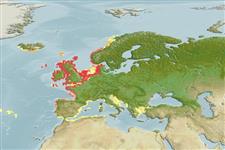Acrocnida brachiata (Montagu, 1804)
Sand burrowing brittle star| Native range | All suitable habitat | Point map | Year 2050 |

|
| This map was computer-generated and has not yet been reviewed. |
| Acrocnida brachiata AquaMaps Data sources: GBIF OBIS |
Upload your photos
Google image |
No photo available for this species.No drawings available for Amphiuridae.
Google image |
No photo available for this species.
Classification / Names Common names | Synonyms | CoL | ITIS | WoRMS
Ophiuroidea | Amphilepidida | Amphiuridae
Environment: milieu / climate zone / depth range / distribution range Ecology
Benthic; brackish; depth range 5 - 40 m (Ref. 85345). Temperate
Distribution Countries | FAO areas | Ecosystems | Occurrences | Introductions
Atlantic and the Mediterranean Sea: Europe & Northern Asia (excluding China). Temperate and subtropical.
Length at first maturity / Size / Weight / Age
Maturity: Lm ? range ? - ? cm
Inhabit estuarine and inshore areas, in mud or substrates of silt to fine sand. A microvore that feeds on organic detritus as well as a carnivore-scavenger (Ref. 96352). Free-living (Ref. 3123).
Life cycle and mating behavior Maturity | Reproduction | Spawning | Eggs | Fecundity | Larvae
Members of the class Ophiuroidea are mostly gonochoric, others are protandric. Fertilization is external. Brooding is common, bursae is used as brood chambers where the embryos develop into juveniles and later crawl out from the bursal slits. Life cycle: Embryos hatch into free-swimming planktotrophic larvae and later metamorphose into tiny brittle stars which sink down the bottom where they grow into adult form.
Main reference
References | Coordinator | Collaborators
Garmendia, J.M., J.M. Parada and J. Mora. 2003. (Ref. 2795)
IUCN Red List Status (Ref. 130435)
CITES status (Ref. 108899)
Not Evaluated
CMS (Ref. 116361)
Not Evaluated
Threat to humans
Human uses
| FishSource |
Tools
More information
Age/Size
Growth
Length-weight
Length-length
Morphology
Larvae
Abundance
Growth
Length-weight
Length-length
Morphology
Larvae
Abundance
Internet sources
BHL | BOLD Systems | CISTI | DiscoverLife | FAO(Publication : search) | Fishipedia | GenBank (genome, nucleotide) | GloBI | Gomexsi | Google Books | Google Scholar | Google | PubMed | Tree of Life | Wikipedia (Go, Search) | Zoological Record
Estimates based on models
Preferred temperature
(Ref. 115969): 8.4 - 12.4, mean 10.3 (based on 164 cells).
Price category
(Ref. 80766):
Unknown.


